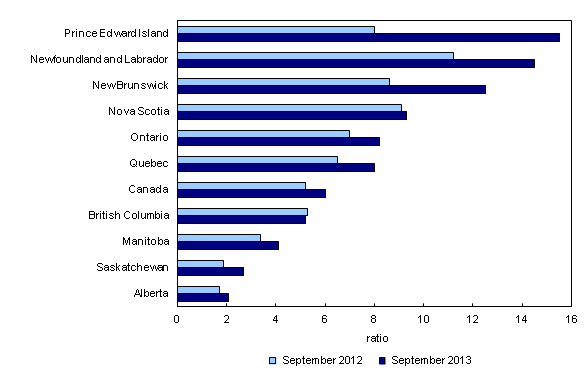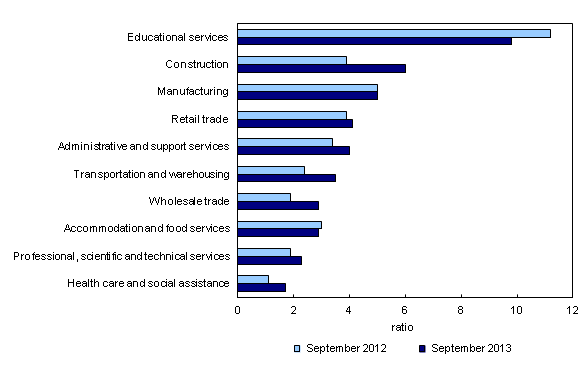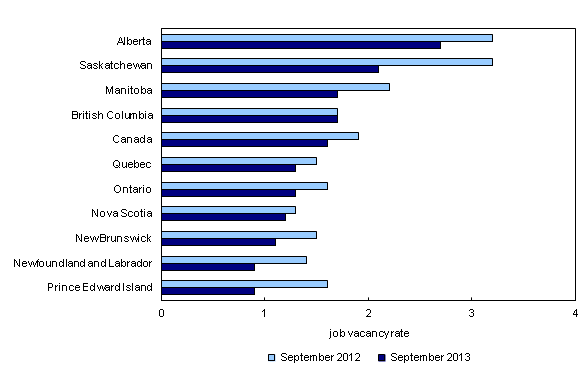Job vacancies, three-month average ending in September 2013
Archived Content
Information identified as archived is provided for reference, research or recordkeeping purposes. It is not subject to the Government of Canada Web Standards and has not been altered or updated since it was archived. Please "contact us" to request a format other than those available.
Released: 2013-12-17
Canadian businesses reported 229,000 job vacancies in September, down 41,000 from September 2012. For every job vacancy, there were 6.0 unemployed people, up from 5.2 one year earlier. The increase in the unemployment-to-job vacancies ratio was the result of fewer job vacancies, as the number of unemployed people was little changed.
Ratio increases in six provinces
The unemployment-to-job vacancies ratio increased in six provinces, as a result of fewer job vacancies.
Prince Edward Island had the largest change in the unemployment-to-job vacancies ratio, up from 8.0 unemployed people for every job vacancy in September 2012 to 15.5 in September 2013 (see "Data quality" in the Note to readers).
Ontario's unemployment-to-job vacancies ratio went up from 7.0 to 8.2, as the number of job vacancies fell faster than the number of unemployed people.
The ratio also rose in New Brunswick, Quebec, Saskatchewan and Alberta. Despite the increases in Saskatchewan and Alberta, the two provinces maintained the lowest unemployment-to-job vacancy ratios.
In the remaining four provinces, the unemployment-to-job vacancy ratios were little changed compared with September 2012.
Ratio by sector
In construction, the unemployment-to-job vacancies ratio rose from 3.9 in September 2012 to 6.0 in September 2013. The increase was a result of fewer job vacancies in this sector.
The ratio in transportation and warehousing increased from 2.4 in September 2012 to 3.5 in September 2013. There were more unemployed people in this sector and fewer job vacancies.
In wholesale trade, the ratio was 2.9 in September, up from 1.9 a year earlier. The increase in the ratio was due to fewer job vacancies, as the number of unemployed people was little changed.
The unemployment-to-job vacancy ratio in health care and social assistance was 1.7 in September, the lowest among the largest industrial sectors. This ratio was up from 1.1 in September 2012.
Among the large industrial sectors, educational services had the highest number of unemployed people per vacancy, at 9.8 in September, a result of the large number of unemployed people in this sector during the summer months. This ratio was little changed from both September 2011 and September 2012.
Among the smaller industrial sectors, three had a notable increase in their ratio while one had a decline.
Arts, entertainment and recreation, and mining, quarrying and oil and gas extraction saw an increase in their ratio over the 12-month period, as both posted decreases in the number of job vacancies. The ratio also grew in finance and insurance, entirely as a result of more unemployed people in this sector.
The information and culture sector saw its ratio decline from 2.7 to 1.7 over the 12-month period, as the number of job vacancies increased.
Job vacancy rates
The job vacancy rate is defined as the number of vacant positions divided by total labour demand, that is, occupied positions plus vacant positions. It corresponds to the share of jobs that are unfilled out of all payroll jobs available. Higher job vacancy rates are often associated with periods of economic growth, while lower rates may be associated with periods of slower growth or economic contraction.
In September, the national job vacancy rate among Canadian businesses was 1.6%, down from 1.9% a year earlier.
Provincially, the job vacancy rate declined in seven provinces. Saskatchewan had the largest decrease, its rate falling 1.1 percentage points to 2.1% in the 12 months to September. The rate was little changed in British Columbia, Quebec, and Nova Scotia over the same period.
Among the industrial sectors, the job vacancy rate declined in eight sectors, increased in one, and was little changed in the others.
Health care and social assistance had 31,000 job vacancies and a job vacancy rate of 1.8% in September, down from 2.7% a year earlier. The mining, quarrying and oil and gas extraction sector saw its rate decline from 2.8% to 1.5% over the same period, with 3,500 job vacancies in September.
The job vacancy rate in transportation and warehousing fell from 1.9% to 1.5% in the 12-month period, with 11,000 job vacancies in September. Construction saw its rate decline from 2.0% to 1.4%, with 14,000 vacancies.
There were also declines in regional and Aboriginal public administration; wholesale trade; real estate and rental and leasing; and arts, entertainment and recreation.
Information and culture was the only sector that saw its job vacancy rate increase. The rate grew from 2.0% to 2.9% over the 12 month period, and the sector had 9,500 job vacancies in September.
Note to readers
Estimates of job vacancies are collected through the monthly Business Payrolls Survey (BPS). Starting with the January 2011 reference month, two questions were added to the BPS, which is the survey portion of the Survey of Employment, Payrolls and Hours. These questions were: Did you have any vacant positions on the last business day of the month, and how many?
The target population is the same as that of the BPS and comprises all employers in Canada, except those primarily involved in: agriculture; fishing and trapping; private household services; religious organizations; the military personnel of the defense services; and federal, provincial and territorial public administration.
With each release, estimates for the current reference month are subject to revision. Estimates have been revised for the previous month. Users are encouraged to request and use the most up-to-date estimates for each month.
Data quality
Job vacancy and unemployment estimates are based on samples, and are therefore subject to sampling variability. Estimates for geographic areas and industries with smaller numbers of vacancies or smaller unemployed populations are subject to greater sampling variability.
To address sampling variability, only differences between estimates that are statistically significant at the 68% confidence interval are discussed in this analysis.
Job vacancy, labour demand and unemployment estimates and their accompanying rates are not seasonally adjusted and should only be compared on a year-over-year basis. Given this is a new data series, trends are not yet available and, therefore, data should be interpreted with caution.
All estimates are based on three-month moving averages. For example, estimates for the current month are based on an average of the estimates from the current month and the previous two months.
Definitions
Job vacancy / vacant position: A position is considered "vacant" if it meets all three of the following conditions: a specific position exists; work could start within 30 days; and the employer is actively seeking employees from outside the organization to fill the position.
Labour demand: Total labour demand is the sum of met (total payroll employment) and unmet (vacant positions) labour demand.
Largest industrial sectors: The sectors with the largest levels of payroll employment for which we have publishable job vacancy data.
Job vacancy rate: The number of vacant positions divided by total labour demand, that is, occupied positions plus vacant positions.
Unemployment-to-job vacancies ratios
All unemployed: The unemployment-to-job vacancies ratio for all unemployed is calculated by dividing the total number of unemployed, regardless of their previous work experience, using Labour Force Survey (LFS) data, by the number of vacant positions. This ratio reflects how many unemployed individuals are available for each vacant position and is a measure of the overall labour market tightness.
By sector: For each sector, the ratio is calculated by dividing the number of unemployed who last worked in that sector in the previous 12 months, using LFS data, by the number of vacant positions in the same sector. This excludes new entrants to the labour market as well as unemployed people who had not worked during the previous 12 months. Unemployment data by sector are known only for those who worked within the previous 12 months.
Use of estimates for the last sector worked does not imply that these unemployed individuals continued to look for work in that sector. This ratio reflects how many unemployed individuals who last worked in that sector are available for each vacant position in the sector. It is a measure of the labour market tightness within that sector.
Job vacancies data for October will be released on January 21, 2014.
Contact information
For more information, contact us (toll-free 1-800-263-1136; 514-283-8300; infostats@statcan.gc.ca).
To enquire about the concepts, methods or data quality of this release, contact Jason Gilmore (613-951-7118; jason.gilmore@statcan.gc.ca), Labour Statistics Division.
- Date modified:




